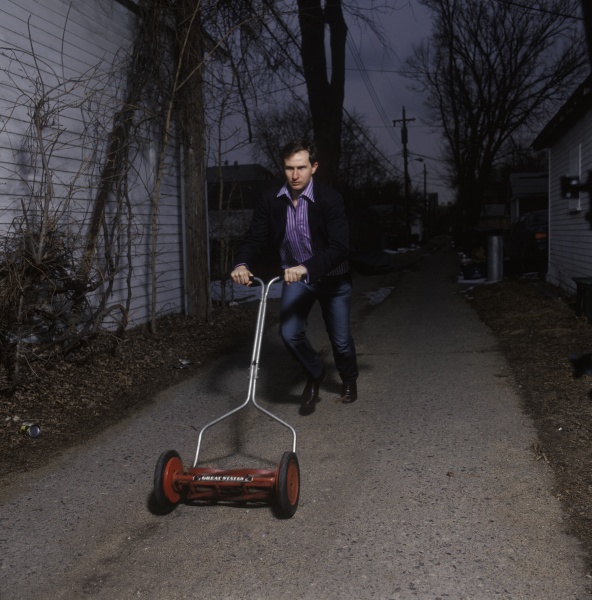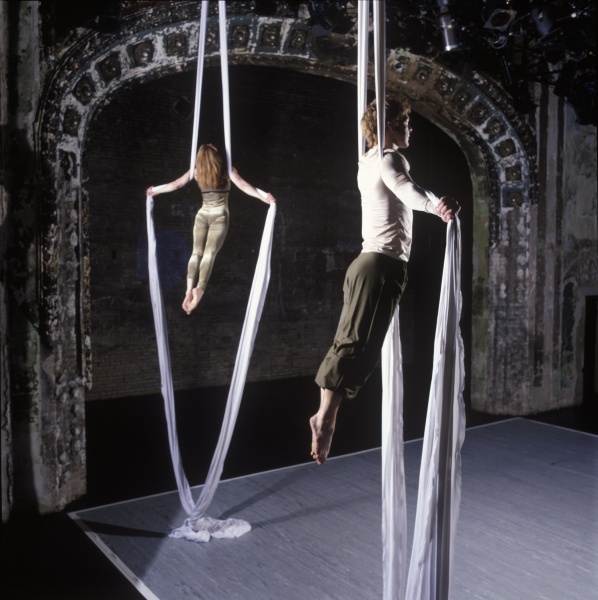Minimal/Maximal at Momentum: Dance
Lightsey Darst reviews the second show in the Momentum series: Colin Rusch's "Dearest 3535" and Risa Cohen's "Two Worlds" at the Southern Theater; copresented by the Walker Art Center, July 22-24.


Colin Rusch: “Dearest 3535”
The man in the purple-striped dress shirt—Colin Rusch—crosses the stage, turns, and stands at the back, waiting for something to move him. The shirt shines like a Jermyn Street window; the man slouches. It’s as if something is going to happen between us, and he is the other audience. What happens is that the immense flower-spider of Bach’s famous toccata and fugue in D minor unfolds, and Rusch gesticulates. Is he conducting? His hands move together, then separately. He’s drawing equations for the end of the universe on a tiny blackboard; he’s refereeing a fast-forwarded football game. He stops and walks away, his face affectless, and we’re left with the electric silk of the music.
Rusch reappears; we might as well not be there, for all the attention he bestows. He feeds an imaginary dog, operates the controls of mission central, preaches an elegant sermon—rapid, astonishingly detailed arm movements. Sometimes he moves his feet; often his hips sway and roll. He’s miming soul food, buying doll groceries. Between passages of intricate gesture he leaves the stage or stands still, giving us air, time to hear the legs of the fugue-spider trampling its web. Smoke enters from an upstage corner and the light goes rose; a last flurry and it’s over.
Later, Eric Boone crosses and recrosses the stage, dressed in a white suit. He’s not doing much. The music, a beachy mix of light and sand, backs up a gull-like quest for nothing in particular: Boone walks a turned-in tightrope, creeps away from us with his head turning methodically from side to side, or extends one hand above his head, palm toward us as if he’s hoping to announce the birth of god. The announcement never comes. Instead, we’re left with the mood of the message, the vision of the modern-day archangel’s Miami Vice white jacket cowling around his neck as he practices his religion.
Next, Kristin Van Loon and Arwen Wilder inhabit the stage in utter silence. Van Loon gestures and darts while Wilder curves and slinks; they don’t acknowledge each other. Each performs a series of preparations for a greater dance that never happens. Christian Gaylord takes the stage to sing (a capella) part of Mozart’s Requiem; then he wanders around, again with a hand held high, and that’s all.
What’s going on? The Requiem and the fugue are keys. Though the Requiem once carried a religious message, it and the fugue now mean almost nothing, and yet they still fill listeners with intense feeling. This peculiar two-dimensional intensity, this bypass of the meaningful for the evocative, is mirrored in Rusch’s inscrutable work. The mood evoked shifts, but between upheld hands, furious yet exact gesture, and several ballet echoes (Rusch’s feet sliding between fourth and fifth positions, his arms in fifth on high, Wilder and Van Loon’s preparations for absent leaps), I felt caught up in old religions (truth? beauty?) that have become mystical to us, their ideals broken, lost, but desired.
That is, I wanted to be caught up. In reality, after the marvelous opening, not quite enough happens to keep the audience’s attention. Rusch doesn’t ask his dancers to copy his idiosyncratic style, in which eccentric movements travel along highly defined pathways, but he doesn’t provide enough motive or motion to fill the resulting void. Rusch’s spare discipline’s admirable, but I wish he would yield a little to the gazer’s desire and give us some big movements, strange props, interaction between dancers, funny faces, small children throwing rose petals, something. All this applies only when Rusch himself is off-stage; when he’s dancing, I don’t want anything else.
Jeff Bartlett’s inspired lighting aids Rusch’s images and his mood. All the dancers are accomplished, but it’s wonderful to see Arwen Wilder (who says she’s dancing for “one and a half people”) luxuriate in her temporary curves.
Risa Cohen: “Two Worlds”
I’m not sure that work less like Colin Rusch’s exists in the Twin Cities. Where Rusch is restrained, seeking (by the end of “Dearest 3535”) a gestural minimum, Cohen’s work is shameless. What you get in this aerial mélange is soap opera drama, pull-out-all-the-stops showmanship, athleticism run amok, and a shameless lust for the beautiful, all set to music that perfectly matches the sideshow/spirit quest feel—a mix of Loreena McKennitt, techno, and what sounds like a massage soundtrack. Everything is a sprung, flung photo op or an out-of-bounds sudden drop, and the audience can’t help applauding mid-piece at the astonishing tricks. Cohen hangs upside-down in a split from a hoop; William Gladden and Cade Holmseth lift each other while revolving on another hoop; Gladden and Denise Armstead soar around stage on a harness; Cohen unravels in a long fall from the cloud-height of her silks; Holmseth raises Cohen in a series of amazing lifts (“No way!” the woman behind me exclaimed at the latest proof of his superhuman strength); and so on. Want more stunts? Go see the show.
It would be easy to complain that “Two Worlds” is more circus than dance, that it has no artistic value. But I’m sure someone’s already doing that, and I’d like to make some other points. First, Cohen puts on a solid show. It’s rapid and visually gratifying, it moves well between pieces, it’s consistent, and the performers are stunning. You may not think much, but you certainly stay awake. Second, aerial dance has too much potential to be shunted aside as a mere circus trick. Right now, a lot of these slow winding climbs up the silks aren’t very rewarding, but I have seen two pieces in which the silks became more a dance surface than a gimmick. And the harness and hoop—which I’ve seen only a few times outside of “Two Worlds”—open even more possibilities. It won’t be long before college programs teach aerial dance and choreographers use it as naturally as they currently use speech.
Yes, “Two Worlds” grinds from trick to trick, frequently with awkward set-ups in between, but this is because Cohen’s at the leading edge of a large wave, not yet in the smooth water of taking these stunts for granted. Also, while the stunts themselves definitely take first place—the sheer thrill of fall and flight—a weak but promising current runs through “Two Worlds,” one in which aerial dance is a metaphor for love. In “First Sight,” Gladden glides around Armstead on a low harness. She can touch him, she can push him, she can even ride with him for a while, but his essential otherness remains. No matter how much you love someone, you can never entirely bridge this gap—one remains one, the other the other. Gladden and Armstead capture this beautifully in their duet.
And that’s the other thing: beauty. Cohen chases it like a hungry cheetah. What she brings back isn’t new—the tawdry beauty of a high-flying split-and-a-bit, for example—but, watching Cohen’s work and hearing the reaction from the crowd, I find we’re a little starved for this essential vitamin. Yes, we need truth, but give us beauty too. It’s the only thing that can make us think we’ll live forever.